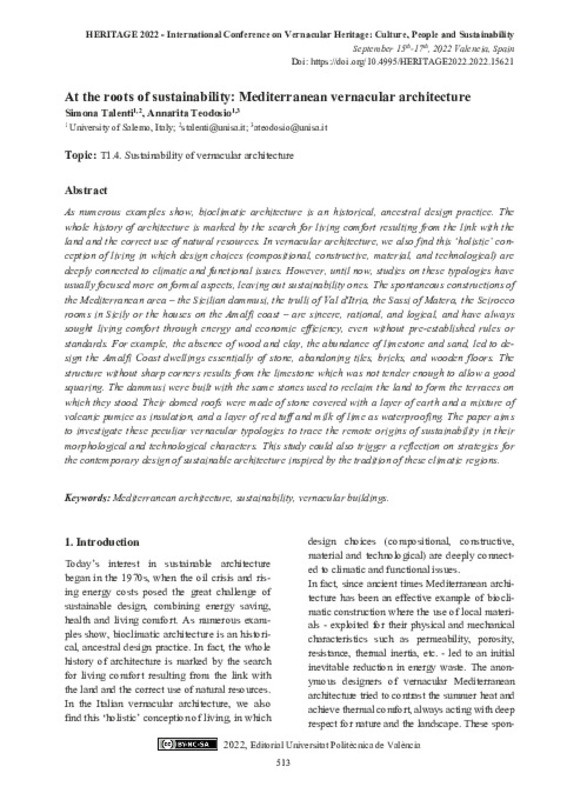JavaScript is disabled for your browser. Some features of this site may not work without it.
Buscar en RiuNet
Listar
Mi cuenta
Estadísticas
Ayuda RiuNet
Admin. UPV
At the roots of sustainability: Mediterranean vernacular architecture
Mostrar el registro sencillo del ítem
Ficheros en el ítem
| dc.contributor.author | Talenti, Simona
|
es_ES |
| dc.contributor.author | Teodosio, Annarita
|
es_ES |
| dc.date.accessioned | 2022-10-27T11:33:56Z | |
| dc.date.available | 2022-10-27T11:33:56Z | |
| dc.date.issued | 2022-09-13 | |
| dc.identifier.isbn | 9788413960203 | |
| dc.identifier.uri | http://hdl.handle.net/10251/188837 | |
| dc.description.abstract | [EN] As numerous examples show, bioclimatic architecture is an historical, ancestral design practice. The whole history of architecture is marked by the search for living comfort resulting from the link with the land and the correct use of natural resources. In vernacular architecture, we also find this ‘holistic’ conception of living in which design choices (compositional, constructive, material, and technological) are deeply connected to climatic and functional issues. However, until now, studies on these typologies have usually focused more on formal aspects, leaving out sustainability ones. The spontaneous constructions of the Mediterranean area – the Sicilian dammusi, the trulli of Val d'Itria, the Sassi of Matera, the Scirocco rooms in Sicily or the houses on the Amalfi coast – are sincere, rational, and logical, and have always sought living comfort through energy and economic efficiency, even without pre-established rules or standards. For example, the absence of wood and clay, the abundance of limestone and sand, led to design the Amalfi Coast dwellings essentially of stone, abandoning tiles, bricks, and wooden floors. The structure without sharp corners results from the limestone which was not tender enough to allow a good squaring. The dammusi were built with the same stones used to reclaim the land to form the terraces on which they stood. Their domed roofs were made of stone covered with a layer of earth and a mixture of volcanic pumice as insulation, and a layer of red tuff and milk of lime as waterproofing. The paper aims to investigate these peculiar vernacular typologies to trace the remote origins of sustainability in their morphological and technological characters. This study could also trigger a reflection on strategies for the contemporary design of sustainable architecture inspired by the tradition of these climatic regions. | es_ES |
| dc.format.extent | 8 | es_ES |
| dc.language | Inglés | es_ES |
| dc.publisher | Editorial Universitat Politècnica de València | es_ES |
| dc.relation.ispartof | Proceedings HERITAGE 2022 - International Conference on Vernacular Heritage: Culture, People and Sustainability | |
| dc.rights | Reconocimiento - No comercial - Compartir igual (by-nc-sa) | es_ES |
| dc.subject | Sustainability | es_ES |
| dc.subject | Vernacular architecture | es_ES |
| dc.subject | Mediterranean architecture | es_ES |
| dc.subject | Vernacular buildings | es_ES |
| dc.title | At the roots of sustainability: Mediterranean vernacular architecture | es_ES |
| dc.type | Capítulo de libro | es_ES |
| dc.type | Comunicación en congreso | es_ES |
| dc.identifier.doi | 10.4995/HERITAGE2022.2022.15621 | |
| dc.rights.accessRights | Abierto | es_ES |
| dc.description.bibliographicCitation | Talenti, S.; Teodosio, A. (2022). At the roots of sustainability: Mediterranean vernacular architecture. En Proceedings HERITAGE 2022 - International Conference on Vernacular Heritage: Culture, People and Sustainability. Editorial Universitat Politècnica de València. 513-520. https://doi.org/10.4995/HERITAGE2022.2022.15621 | es_ES |
| dc.description.accrualMethod | OCS | es_ES |
| dc.relation.conferencename | HERITAGE2022 International Conference on Vernacular Heritage: Culture, People and Sustainability | es_ES |
| dc.relation.conferencedate | Septiembre 15-17, 2022 | es_ES |
| dc.relation.conferenceplace | Valencia, España | es_ES |
| dc.relation.publisherversion | http://ocs.editorial.upv.es/index.php/HERITAGE/HERITAGE2022/paper/view/15621 | es_ES |
| dc.description.upvformatpinicio | 513 | es_ES |
| dc.description.upvformatpfin | 520 | es_ES |
| dc.type.version | info:eu-repo/semantics/publishedVersion | es_ES |
| dc.relation.pasarela | OCS\15621 | es_ES |








